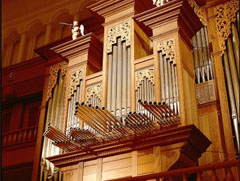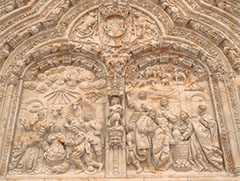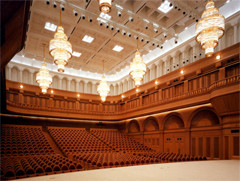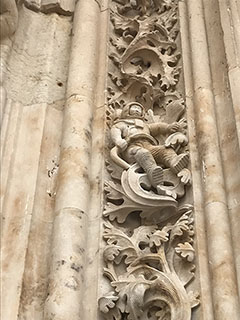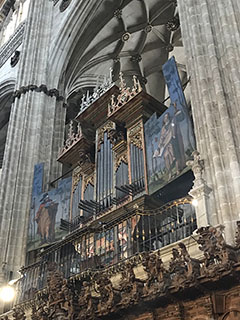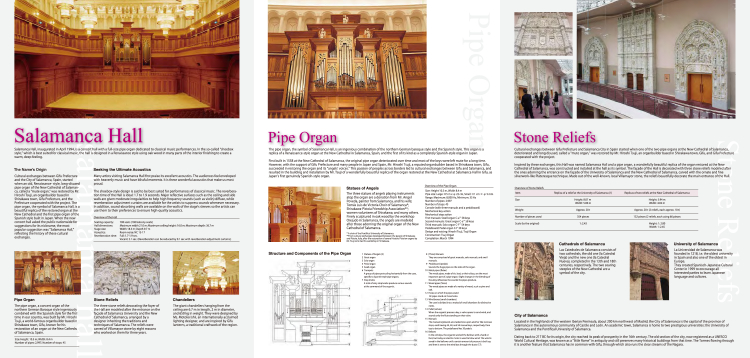
Salamanca Hall, inaugurated in April 1994, is a concert hall with a full-size pipe organ dedicated to classical music performances. In the so-called “shoebox style,” which is best suited for classical music, the hall is designed in a Renaissance style using oak wood in many parts of the interior finishing to create a warm, deep feeling.
The Name’s Origin
Cultural exchanges between Gifu Prefecture and the City of Salamanca, Spain, started when an old, Renaissance- style, long-disused pipe organ of the New Cathedral of Salamanca, called a "mute organ," was restored by Mr. Hiroshi Tsuji, an organbuilder based in Shirakawa town, Gifu Prefecture, and the Prefecture cooperated with the project. The pipe organ, the symbol of Salamanca Hall, is a beautiful replica of the restored organ at the New Cathedral and the first pipe organ of the Spanish style built in Japan. When the new concert hall asked the public nationwide for suggestions for its name, the most popular suggestion was "Salamanca Hall," reflecting the history of these cultural exchanges.
Seeking the Ultimate Acoustics
Many artists visiting Salamanca Hall first praise its excellent acoustics. The audiences feel enveloped with heavenly music and have blissful moments. It is these wonderful acoustics that make us most proud.
The shoebox-style design is said to be best suited for performances of classical music. The reverberation time of the Hall is ideal: 1.7 to 1.9 seconds. Major reflective surfaces such as the ceiling and side walls are given moderate irregularities to help high frequency sounds (such as violin) diffuse, while reverberation adjustment curtains are available for the artists to suppress sounds whenever necessary. In addition, sound-absorbing walls are available on the walls of the stage's sleeves so the artists can use them to their preferences to ensure high-quality acoustics.
Overview of the Hall
| Seating capacity | 708 seats (106 balcony seats) [Seating Chart] |
|---|---|
| Hall dimensions | Maximum width 21.0 m; Maximum ceiling height: 16.1 m; Maximum depth: 36.7 m |
| Stage size | Width 18.3 m; Depth 9.7 m |
| Acoustics | Room noise: NC 15-17 |
| Reverberation time | Full: 1.7-1.9 sec. |
| Vacant: 2.1 sec. (Reverberation can be reduced by 0.1 sec with reverberation adjustment curtains.) |
 Pipe Organ
Pipe Organ
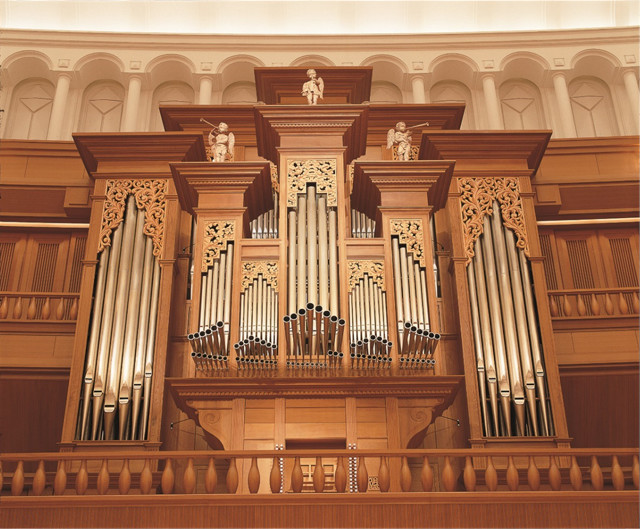
The pipe organ, the symbol of Salamanca Hall, is an ingenious combination of the northern German baroque style and the Spanish style. This organ is a replica of a Renaissance-style organ at the New Cathedral in Salamanca, Spain, and the first of its kind as a completely Spanish-style organ in Japan.
First built in 1558 at the New Cathedral of Salamanca, the original pipe organ deteriorated over time and most of the keys were left mute for a long time. However, with the support of Gifu Prefecture and many people in Japan and Spain, Mr. Hiroshi Tsuji, a reputed organbuilder based in Shirakawa town, Gifu, succeeded in restoring the organ and its "angels’ voices." This passion of peoples across borders led to cultural exchanges between Gifu and Salamanca, and resulted in the building and installation by Mr. Tsuji of a wonderfully beautiful replica of the organ restored at the New Cathedral at Salamanca Hall in Gifu, as Japan's first genuinely Spanish-style organ.
Statues of Angels
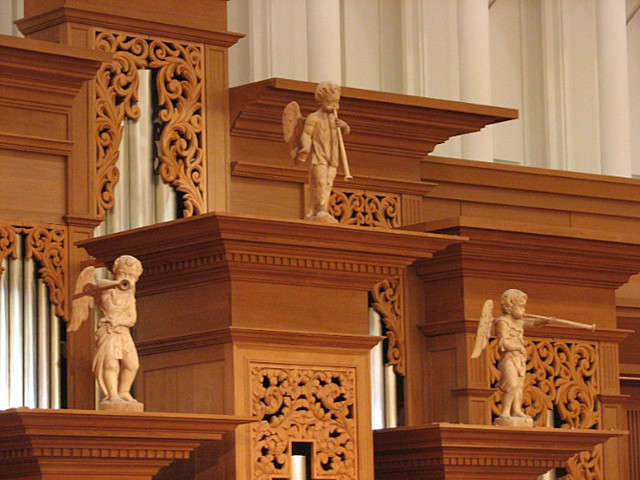
The three statues of angels playing instruments atop the organ are a donation from Mr. Angel Poveda, painter from Salamanca, and his wife; Tomás Luis de Victoria Choir of Salamanca*; Shirakawa-Pistoia Friendship Association**; women volunteers of Shirakawa; and many others. Finely sculptured in oak wood by the workshop Orejudo in Salamanca, the angels are modeled after those adorning the original organ of the New Cathedral of Salamanca.
* A choir of the Pontifical University of Salamanca.
** From cultural exchanges developed between the people of Shirakawa and Pistoia, Italy, after the restoration of several historic Pistoian organs by Mr. Tsuji who had his workshop in Shirakawa.
Overview of the Pipe Organ
- Size: Height 10.5 m, Width 8.4 m
- Pipe size: Large: H 5 m x φ 22 cm, Small: H 1 cm × φ 5 mm
- Range: Maximum: 8,000 Hz, Minimum: 33 Hz
- Number of pipes: 2,997
- Number of stops: 45
- Console (with three-manuals and a pedalboard)
- Mechanical key action
- Mechanical stop action
- First manuals: Swell organ C-a’’’ 58 keys
- Second manuals: Great organ C-a’’’ 58 keys
- Third manuals: Solo organ C-f’’’ 54 keys
- Pedalboard: Pedal organ C-f’ 30 keys
- Design and voicing: Hiroshi Tsuji, Tsuji Organ
- Construction: Tsuji Organ
- Completion: March 1994
Structure and Components of the Pipe Organ
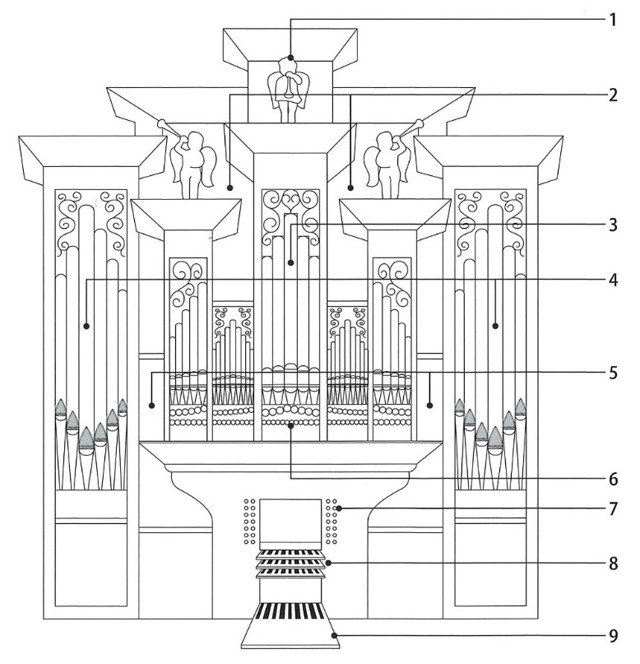
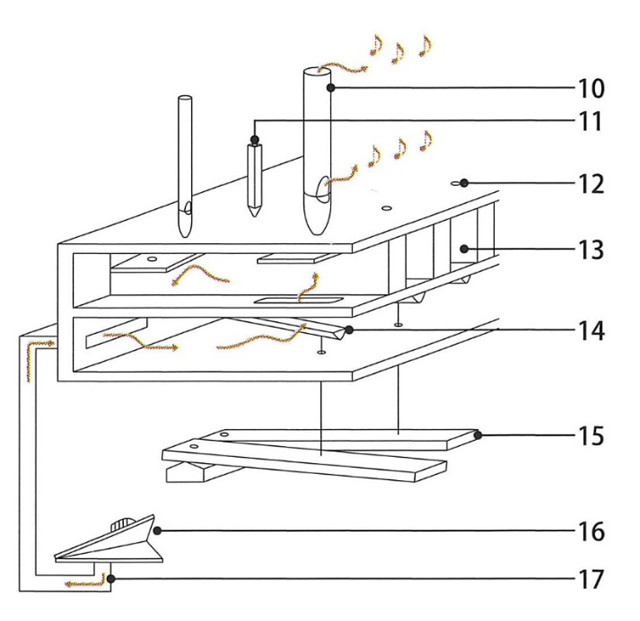
Inside the pipe organ
- Statues of Angels (3)
- Great organ
- Solo organ
- Pedal organ
- Swell organ
- Trumpets
A group of pipes protruding horizontally from the case, specific to Spanish-style pipe organs.
- Stop knobs
A total of sixty stop knobs produce various sounds at the command of the organist.- (Three) Manuals
They are comprised of great manuals, solo manuals, and swell manuals.- Pedalboard (pedals)
Sounds the huge pipes on the sides of the organ.- Metal pipes (flutes)
The metal pipes, made of tin, lead, or their alloys, are the most important part of a pipe organ. Slight changes in the blending of the alloy influences the sounds the pipes produce.- Wood pipes (flutes)
The wood pipes are made of a variety of wood, such as pine and oak.- Holes on which the pipes stand
All pipes stand on these holes.- Wind boxes (small chambers)
The case is divided into a myriad of small chambers for distinctive notes.- Pallet (valves)
When the organist presses a key, a valve opens to send wind, and sounds only the flute standing on that valve.- Manuals
The manual keyboards are stacked one upon another like staircase steps, each having 54, 58, and 58 manual keys, respectively, from top to bottom. The pedalboard has 30 pedals.- Bellows
In the old days, the organist worked the bellows with a hand or foot, but today an electric motor is used to blow wind. The wind is saved in the bellows until a certain amount of pressure is built up, and then is sent to the wind box through the ducts (17). - Stop knobs
 Stone Reliefs
Stone Reliefs
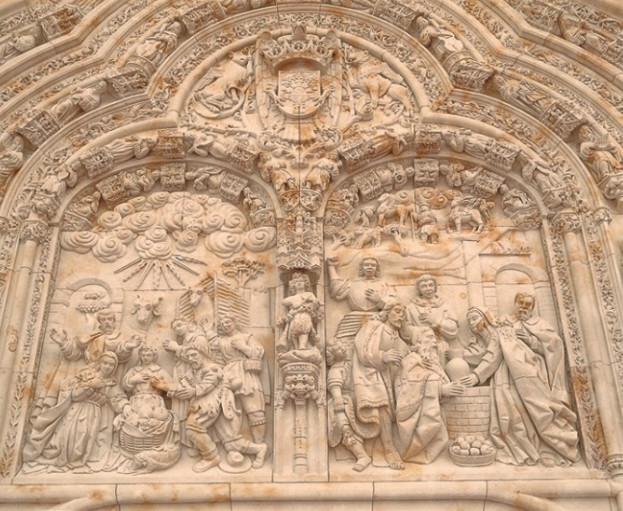
The three stone reliefs decorating the foyer of the Hall are modeled after the entrance on the facade of Salamanca University and the New Cathedral of Salamanca, arranged by a designer inheriting the traditions and techniques of Salamanca. The reliefs were carved of Villamayor stone by eight masons who worked on them for three years.
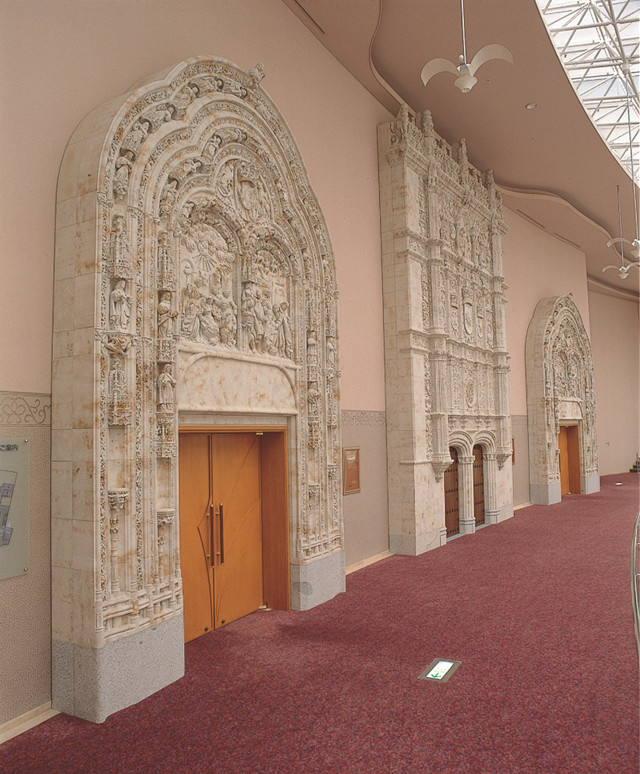
Overview of Stone Reliefs
| Replica of a relief at the University of Salamanca (1) | Replicas of two reliefs at the New Cathedral of Salamanca | |
|---|---|---|
| Size |
Height: 8.07 m Width: 5.00 m |
Height: 5.94 m Width: 4.02 m |
| Weight | Approx. 20t | Approx. 20t (2 reliefs, each approx. 10t) |
| Number of pieces used |
354 pieces | 132 pieces (2 reliefs, each using 66 pieces) |
| Scale (to the original) |
1: 2.43 |
Height: 1: 2.80 Width: 1: 2.45 |
| Materials |
|
|
| Production time | 3 years (in Spain) 1994-1996 | |
| Construction time | 6 months (in Japan) | September 12, 1997 - March 10, 1998 |
| Transportation time |
28 days | November 6 - December 3, 1997 |
| Design | Francisco Garcia Gomez | Architect in Salamanca |
| Production | Sanchón Diego, S.L. having a masonry workshop in the village of Villamayor | |
 Chandeliers
Chandeliers
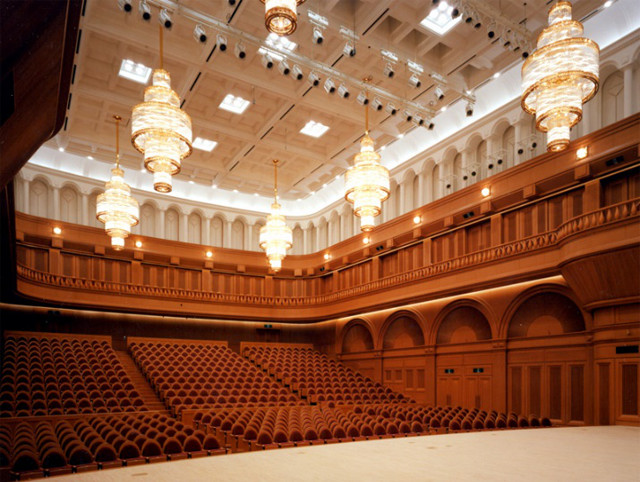

The giant chandeliers hanging from the ceiling are 6.7 m in length, 2 m in diameter, and 650 kg in weight. They were designed by Ms. Motoko Ishii, an internationally acclaimed lighting designer, and are inspired by Gifu lanterns, a traditional craftwork of the region.
 City of Salamanca
City of Salamanca
Located in the highlands of the western Iberian Peninsula, about 200 km northwest of Madrid, the City of Salamanca is the capital of the province of Salamanca in the autonomous community of Castile and León. An academic town, Salamanca is home to two prestigious universities: the University of Salamanca and the Pontifical University of Salamanca.
Dating back to 217 BC for its origin, the city reached its peak of prosperity in the 16th century. The old section of the city, now registered as a UNESCO World Cultural Heritage, was known as a “little Rome” in antiquity and still preserves many historical buildings from that time. The Tormes flowing through it is another feature that Salamanca has in common with Gifu, through which also runs the clear streams of the Nagara.
Cathedrals of Salamanca
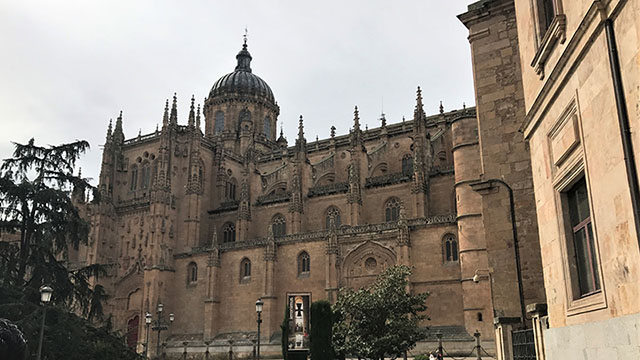
Las Catedrales de Salamanca consists of two cathedrals, the old one (la Catedral Vieja) and the new one (la Catedral Nueva), completed in the 13th and 18th centuries, respectively. The two soaring steeples of the New Cathedral are a symbol of the city.
The Cathedrals’ buildings, entirely made of stone, were built over a long period of time, about 100 years for the Old Cathedral and about 200 years for the New Cathedral.
University of Salamanca
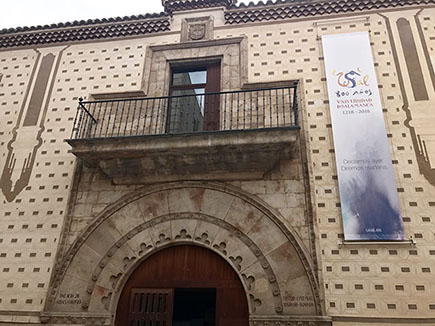
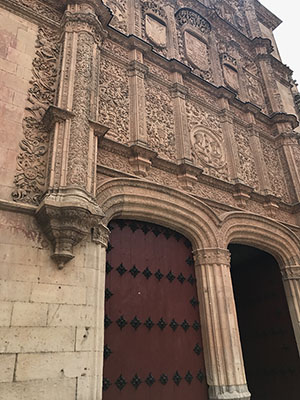
Alongside the Universities of Bologna, Paris, and Oxford, la Universidad de Salamanca is one of the world’s oldest universities. Opened in the 13th century, the university has kept its tradition as a hall of intelligence to this day. It is said that Christopher Columbus, too, consulted a professor at this university about a sea route to India before embarking on his voyage to the New World.


